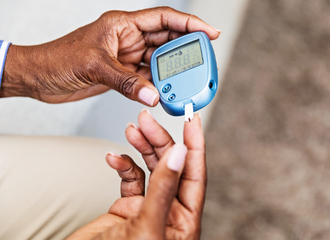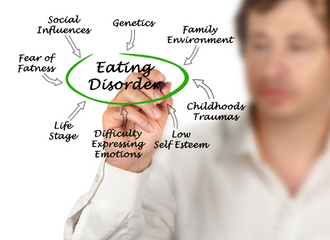Written by: Fatema Jivanjee-Shakir, LMSW
Primary Therapist & Clinical Assessor, The Renfrew Center of New York City

Studies demonstrate that approximately 10% of cisgendered girls and women with diabetes suffer from full threshold eating disorders, and up to 35% of cisgendered girls and women with diabetes suffer from subthreshold eating disorders (Colton, Roding, Bergenstal, & Parkin, 2009). Research on diabetes and eating disorders in cisgender men, transgender individuals and non-binary/ gender non-conforming individuals is limited.
Labeling Food as “Good” and “Bad”
When people are diagnosed with diabetes, there is heightened focus on the amount and type of foods they eat. They are typically recommended to monitor and cut back on their carbohydrates, which can lead them to categorize foods as “good” or “bad.” In doing so, individuals with diabetes often obsess over food labels and become hyperaware of their caloric intake, as well as develop feelings of guilt and shame consuming a “bad” food item.
There are several low-carb diets prescribed for people who suffer from diabetes, including Keto, Paleo and Atkins. While these diets may intend to help those with diabetes, they also promote restriction and rigidity with food, which puts people at an increased risk for developing an eating disorder or relapsing from a pre-existing one.
Diagnosing the Problem
Doctors often recommend that people with diabetes increase their activity levels and reduce their weight to manage their diabetes. This is especially true for people with Type II diabetes, as it is correlated with being in a larger body (Grey, Picone, Sloan, & Yashkin, 2015). This stigmatization is fatphobic and does not account for the structural inequalities and systems of oppression that impact people’s relationships with food and exercise (Union of Concerned Scientists, 2016).
It’s also important to mention that:
- People in larger bodies are less likely to be diagnosed when they have an eating disorder.
- BIPOC individuals are more likely to be in larger bodies than their White counterparts.
- BIPOC individuals are more likely to be diagnosed with diabetes than their White counterparts.
- BIPOC individuals are also less likely to be diagnosed when they have an eating disorder compared to their White counterparts.
(Becker, 2003; Centers for Disease Control and Prevention, 2020; Krueger & Reither, 2015).
This means that BIPOC folks who suffer from both diabetes and an eating disorder are less likely to be diagnosed, and subsequently, less likely to be treated for their eating disorder. The longer an eating disorder remains untreated, the more severe it tends to be (Austin et al., 2020). The systemic barriers that cause additional stress to BIPOC folks who suffer from both diabetes and eating disorders cannot go unmentioned.
Understanding the Dangers of Diabulimia
People with Type I diabetes can also develop diabulimia. Though not an official diagnosis, this terminology is used to describe cases in which people skip the insulin they need to treat their diabetes to lose weight.
When someone has Type I diabetes, it means their body can’t produce insulin, so they can’t process sugars. Their blood sugars rise and are released in their urine, causing weight loss. When people who suffer from Type I diabetes begin insulin treatment, their weight tends to increase. This can result in body image distress, which can lead to skipping insulin to manage their weight.
Once diabetes develops, it’s a long-term condition. There is no cure that will make it go away for good. This can feel devastating and stressful for many and can feel like they’ve lost control over their body. Managing food and exercise is often an attempt to re-establish control. Furthermore, for people who struggle with perfectionism, counting carbohydrates and aiming for perfect blood sugar levels can trigger on obsessive thoughts about food and exercise as people strive to be “the perfect diabetic.”
Treating Diabetes & Eating Disorders Together
Recovery from an eating disorder is possible and help is available. You do not have to navigate this process alone—it can be helpful to work with a team of providers (i.e., an endocrinologist, dietitian, therapist, and psychiatrist) to explore how diabetes and the eating disorder intersect. Together, your team can help you develop ways to effectively manage both.


